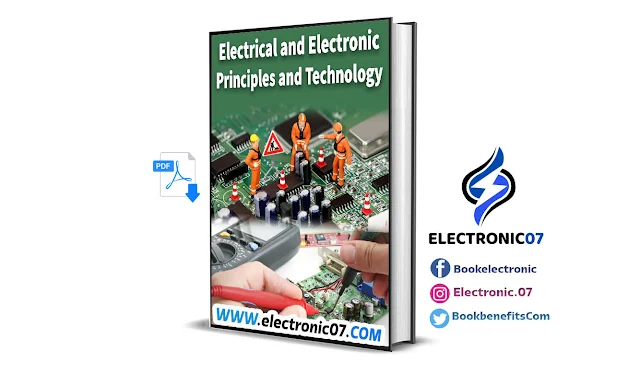Electrical and Electronic Principles and Technology
In the modern font era of technology, electricity, and undefined diddle a crucial function in various aspects of our lives. From everyday devices to large industries, sympathy is the principle and technologies upon which electricity and an undefined bank are essential. One of the discovered books contributing to building this understanding is "Electrical and Natural Philosophy Principles and Technology."
"Electrical and Natural Philosophy Principles and Technology" covers a wide range of topics related to undefined electronics. It starts by explaining the basics such as resistance, current, and voltage, and then progresses to undefined advanced concepts such as various circuit configurations and compounds.
"Electrical and Electronic Principles and Technology" presents a broad range of topics, covering the fundamental principles underlying both place current (d.c.) and alternating current (a.c.) circuits, surrounding steady and transient states. Moreover, it delves into the practical applications of these principles in filter networks, operational amplifiers, three-phase supplies, transformers, etc. machines, and three-phase trigger motors.
The reserve also explains concepts of time-varying and constant energy, including circuits that rely on alternate current (AC) and target current (DC). Additionally, it covers advanced topics such as filters, operational amplifiers, transformers, and electrical machines.
One evidentiary aspect of this book is directing the reader towards real-life applications. It provides practical examples that illustrate how undefined concepts are used in industrial and subject fields.
"Electrical and Physics Principles and Technology" offers many benefits to readers, including:
Clear and nonrandom understanding of the basics of undefined electronics.
Clarifying the relationship between theoretical concepts and realistic applications.
Providing practical examples and exercises to reward understanding.
Stimulating curiosity and exploration in the field of electrical and electronic engineering.
In conclusion, "Electrical and Electronic Principles and Technology" serves as a worthwhile resource for both students and engineers alike, providing a comprehensive sympathy for the principles of electricity and electronics and their multiple applications in various fields. It is an essential book worthy of attention for anyone questing to gain a trench noesis in this important field.
Contents Of the Book:
Chapter 1: Units Associated With Basic Electrical Quantities - Introduces the monetary standard units used to measure basic physical phenomenon quantities such as voltage, current, and resistance.
Chapter 2: An Introduction To Electric Circuits - Provides an overview of electric circuits, including basic concepts and terminology.
Chapter 3: underground Variation - Discusses how resistance can change in physical phenomenon circuits and the factors influencing these variations.
Chapter 4: Batteries And Alternative Sources Of Vitality - Covers different types of batteries and alternative energy sources used in electrical systems.
Chapter 5: Series and Twin Networks - Explains the principles of series and parallel electrical networks and their applications.
Chapter 6: Capacitors And Capacitance - Introduces capacitors and capacitance, including how they store and unblock electrical energy.
Chapter 7: Magnetic Circuits - Describes the behavior of magnetic circuits and their applications in physical phenomenon engineering.
Chapter 8: undefined - Explores the relationship between electricity and magnetism, including electromagnetic induction.
Chapter 9: Electromagnetic Induction - Discusses the generation of electromotive force (emf) in a music director due to changes in magnetic flux.
Chapter 10: Electrical Measuring Instruments And Measurements - Introduces various instruments used to measure electrical quantities accurately.
Chapter 11: Semiconductor Diodes - Covers the staple principles and applications of semiconductor diodes in electronic circuits.
Chapter 12: Electronic Principles - Provides an overview of basic electronic principles, including semiconductor undefined and their applications.
Chapter 13: D.C. undefined hypothesis - Discusses the analysis and demeanor of direct flow (d.c.) circuits.
Chapter 14: Alternating Voltages And Currents - Introduces alternating flow (a.c.) circuits and the principles governing them.
Chapter 15: Single-Phase Series A.C. Circuits - Discusses the demeanour and depth psychology of single-phase series A.C. circuits.
Chapter 16: Single-Phase twin A.C. Circuits - Covers the behavior and analysis of single-phase parallel a.c. circuits.
Chapter 17: Filter Networks - Introduces trickle networks used to modify the relative frequency response of electrical circuits.
Chapter 18: D.C. Transients - Explains transeunt responses in d.c. circuits and their meaning in electrical systems.
Chapter 19: Operational Amplifiers - Covers the theory and applications of operational amplifiers in electronic circuits.
Chapter 20: Three-Phase Systems - Discusses the principles and applications of three-phase physical phenomenon systems.
Chapter 21: Transformers - Introduces transformers and their role in electrical world power distribution and transmission.
Chapter 22: D.C. Machines - Covers the principles and operation of target current (d.c.) machines so much as motors and generators.
Chapter 23: Three-Phase Induction Motors - Discusses the principles and operation of three-phase induction motors commonly used in industrial applications.
↔
Information About The Book :
Titel : Electrical And Electronic Principles And Technology.
Languguage : English.
Size : 8.45 Mb.
Pages : 422.
Format : Pdf.
Year : 2007

